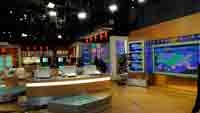CBS relaunches ‘Early Show’ with new HD set

Looking to boost rating and skew to a younger audience, CBS relaunched its “Early Show” with a colorful new widescreen set on Monday, Jan. 7, that features mood lighting and open spaces for unobstructed interaction between the different on-air talent.
The new set, designed by James Fenhagen (production designer), Larry Hartman (art director), of New York-based Production Design Group (PDG), was constructed in one month’s time, which kept crews working around the clock, right through the holidays.
This included knocking down a wall separating the existing Studio A and B (former home of WCBS newscasts and, later, previous “Early Show” cooking segments) to create 5100sq-ft of studio space, which in turn necessitated a significant amount of new power wiring and video cable runs.
According to Frank Governale, vice president of operations, the set includes dozens of LCD and plasma displays and LED light boxes, with more than 500 DMX channels allocated solely to the fixtures. “All of the displays are RGB, so we can control each one of those squares,” Governale said. “Every square can be a different color and individually shaded to create a specific mood.”
Leveraging existing Sony F900 series HD cameras and the same control room (with a Sony HD switcher), the lighting in the studio was mounted higher on the grid than usual, which helps illuminate wide staging areas and give the illusion of a large, spacious set.
“A lot more attention was paid to the lighting design than in the past,” Governale said. “We don’t just use flood lights anymore.”
The floor of the studio has been releveled and painted to look like wood. The same control room is used, although a number of new DDRs have been added to handle the increased amount of monitors on-set. The new set also includes two 103in Panasonic plasma displays as main backdrops, and about a dozen other displays.
The professional video industry's #1 source for news, trends and product and tech information. Sign up below.
“The look for the new set speaks to the new format of the ‘Early Show,’ and the audience that we’re trying to attract,” said Governale. “It’s inviting people into your house or apartment, with a loft-style setting. There’s a lot of relationship shots, whereby the talent interacts with each other, which helps brings the audience into the discussion as opposed to watching from afar.”
